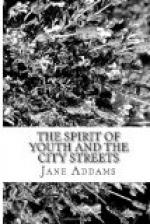In such neighborhoods the joy of youth is well nigh extinguished; and in that long procession of factory workers, each morning and evening, the young walk almost as wearily and listlessly as the old. Young people working in modern factories situated in cities still dominated by the ideals of Puritanism face a combination which tends almost irresistably to overwhelm the spirit of youth. When the Puritan repression of pleasure was in the ascendant in America the people it dealt with lived on farms and villages where, although youthful pleasures might be frowned upon and crushed out, the young people still had a chance to find self-expression in their work. Plowing the field and spinning the flax could be carried on with a certain joyousness and vigor which the organization of modern industry too often precludes. Present industry based upon the inventions of the nineteenth century has little connection with the old patterns in which men have worked for generations. The modern factory calls for an expenditure of nervous energy almost more than it demands muscular effort, or at least machinery so far performs the work of the massive muscles, that greater stress is laid upon fine and exact movements necessarily involving nervous strain. But these movements are exactly of the type to which the muscles of a growing boy least readily respond, quite as the admonition to be accurate and faithful is that which appeals the least to his big primitive emotions. The demands made upon his eyes are complicated and trivial, the use of his muscles is fussy and monotonous, the relation between cause and effect is remote and obscure. Apparently no one is concerned as to what may be done to aid him in this process and to relieve it of its dullness and difficulty, to mitigate its strain and harshness.
Perhaps never before have young people been expected to work from motives so detached from direct emotional incentive. Never has the age of marriage been so long delayed; never has the work of youth been so separated from the family life and the public opinion of the community. Education alone can repair these losses. It alone has the power of organizing a child’s activities with some reference to the life he will later lead and of giving him a clue as to what to select and what to eliminate when he comes into contact with contemporary social and industrial conditions. And until educators take hold of the situation, the rest of the community is powerless.
In vast regions of the city which are completely dominated by the factory, it is as if the development of industry had outrun all the educational and social arrangements.
The revolt of youth against uniformity and the necessity of following careful directions laid down by some one else, many times results in such nervous irritability that the youth, in spite of all sorts of prudential reasons, “throws up his job,” if only to get outside the factory walls into the freer street, just as the narrowness of the school inclosure induces many a boy to jump the fence.




